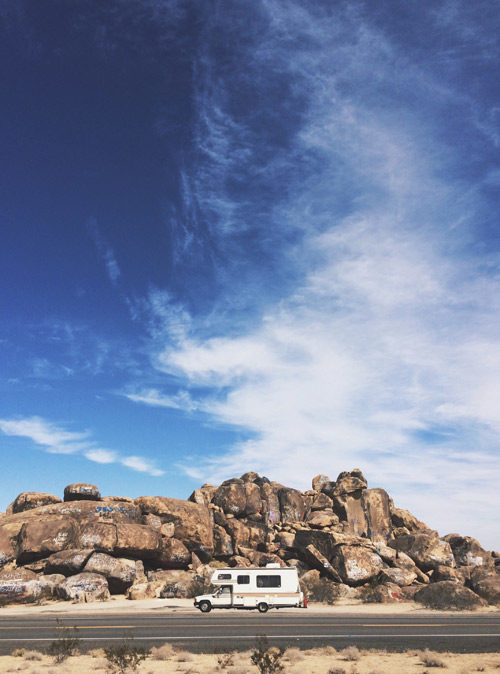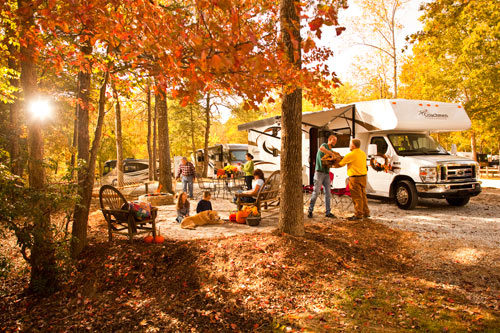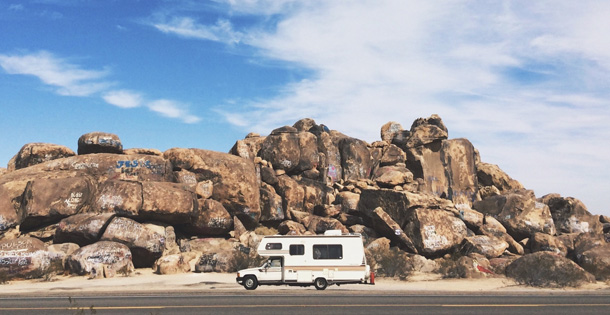
In Drayton, North Dakota, a former San Francisco cabdriver, 67, labors at the annual sugar beet harvest. He works from sunrise until after sunset in temperatures that dip below freezing, helping trucks that roll in from the fields disgorge multi-ton loads of beets. At night he sleeps in the van that is his home.
In New Bern, North Carolina, a woman whose home is a teardrop-style trailer — so small it can be pulled with a motorcycle — is couch surfing with a friend while hunting for work. Even with a master’s degree, the 38-year-old Nebraska native can’t find a job despite filling out hundreds of applications in the past month alone. She knows the sugar beet harvest is hiring, but traveling halfway across the country would require more cash than she has. Losing her job at a nonprofit several years ago is one of the reasons she moved into the trailer in the first place. After the funding for her position ran out, she couldn’t afford rent on top of paying off student loans.
In San Marcos, California, a 30-something couple in a 1975 GMC motorhome is running a roadside pumpkin stand with a children’s carnival and petting zoo, which they had five days to set up from scratch on a vacant dirt lot. In a few weeks, they’ll switch to selling Christmas trees.
In Colorado Springs, Colorado, a 72-year-old van dweller who cracked three ribs doing a campground maintenance job is recuperating while visiting with family.
There have always been itinerants, drifters, hobos, restless souls. But now, in the third millennium, a new kind of wandering tribe is emerging. People who never imagined being nomads are hitting the road. They’re giving up traditional houses and apartments to live in what some call “wheel estate” — vans, secondhand RVs, school buses, pickup campers, travel trailers, and plain old sedans. They are driving away from the impossible choices that face what used to be the middle class. Decisions like: Would you rather have food or dental work? Pay your mortgage or your electric bill? Make a car payment or buy medicine? Cover rent or student loans? Purchase warm clothes or gas for your commute?
For many, the answer seemed radical at first.
You can’t give yourself a raise, but what about cutting your biggest expense? Trading a stick-and-brick domicile for life on wheels?
Some call them “homeless.” The new nomads reject that label. Equipped with both shelter and transportation, they’ve adopted a different word. They refer to themselves, quite simply, as “houseless.”
From a distance, many of them could be mistaken for carefree retired RVers. On occasions when they treat themselves to a movie or dinner at a restaurant, they blend with the crowd. In mindset and appearance, they are largely middle class. They wash their clothes at laundromats and join fitness clubs to use the showers. Many took to the road after their savings were obliterated by the Great Recession. To keep their gas tanks and bellies full, they work long hours at hard, physical jobs. In a time of flat wages and rising housing costs, they have unshackled themselves from rent and mortgages as a way to get by. They are surviving America.
But for them — as for anyone — survival isn’t enough. So what began as a last-ditch effort has become a battle cry for something greater. Being human means yearning for more than subsistence. As much as food or shelter, we require hope.
And there is hope on the road. It’s a byproduct of forward momentum. A sense of opportunity, as wide as the country itself. A bone-deep conviction that something better will come. It’s just ahead, in the next town, the next gig, the next chance encounter with a stranger.
As it happens, some of those strangers are nomads, too. When they meet — online, or at a job, or camping way off the grid — tribes begin to form. There’s a common understanding, a kinship. When someone’s van breaks down, they pass the hat. There’s a contagious feeling: Something big is happening. The country is changing rapidly, the old structures crumbling away, and they’re at the epicenter of something new. Around a shared campfire, in the middle of the night, it can feel like a glimpse of utopia.
As I write, it is autumn. Soon winter will come. Routine layoffs will start at the seasonal jobs. The nomads will pack up camp and return to their real home — the road — moving like blood cells through the veins of the country. They’ll set out in search of friends and family, or just a place that’s warm. Some will journey clear across the continent. All will count the miles, which unspool like a filmstrip of America. Fast-food joints and shopping malls. Fields dormant under frost. Auto dealerships, megachurches, and all-night diners. Featureless plains. Feedlots, dead factories, subdivisions, and big-box stores. Snowcapped peaks. The roadside reels past, through the day and into darkness, until fatigue sets in. Bleary-eyed, they find places to pull off the road and rest. In Walmart parking lots. On quiet suburban streets. At truck stops, amid the lullaby of idling engines. Then in the early-morning hours — before anyone notices — they’re back on the highway. Driving on, they’re secure in this knowledge:
The last free place in America is a parking spot.
There’s no clear count of how many people live nomadically in America. Full-time travelers are a demographer’s nightmare. Statistically, they blend in with the rest of the population, since the law requires them to maintain fixed — in other words, fake — addresses. No matter how widely they wander, nomads must be officially “domiciled” somewhere. Your state of residence is where you get vehicles registered and inspected, renew drivers’ licenses, pay taxes, vote, serve on juries, sign up for health insurance (except for those on Medicare), and fulfill a litany of other responsibilities. And living nowhere, it turns out, means you can live anywhere you want, at least on paper. So many folks opt for residency in the places with the fewest hassles — Florida, South Dakota, and Texas, which lack state income taxes, are longtime favorites — and use mail-forwarding services to stay in touch. The rules for becoming a South Dakotan are especially laid-back. Spend one night at a local motel and register with a South Dakota mail forwarding service. Then show both receipts to the state department of public safety and you’re in.
Many of these people call themselves workampers. One of them — a man I’ll call Don Wheeler — defined that term with great flair, writing in a Facebook direct message to me:
Workampers are modern mobile travelers who take temporary jobs around the U.S. in exchange for a free campsite — usually including power, water, and sewer connections — and perhaps a stipend. You may think that workamping is a modern phenomenon, but we come from a long, long tradition. We followed the Roman legions, sharpening swords and repairing armor. We roamed the new cities of America, fixing clocks and machines, repairing cookware, building stone walls for a penny a foot and all the hard cider we could drink. We followed the emigration west in our wagons with our tools and skills, sharpening knives, fixing anything that was broken, helping clear the land, roof the cabin, plow the fields, and bring in the harvest for a meal and pocket money, then moving on to the next job. Our forebears are the tinkers.
We have upgraded the tinker’s wagon to a comfortable motor coach or fifth-wheel trailer. Mostly retired now, we have added to our repertoire the skills of a lifetime in business. We can help run your shop, handle the front or back of the house, drive your trucks and forklifts, pick and pack your goods for shipment, fix your machines, coddle your computers and networks, work your beet harvest, landscape your grounds, or clean your bathrooms. We are the techno-tinkers.
The people Wheeler described make up an impressive labor force. Kampgrounds of America (KOA), a major employer of workampers, hires some 1,500 couples each year for its resorts and franchises across the country, a representative told AARP. Workamper News, a bimonthly magazine whose website features a popular job-listing service, claims to reach 14,000 members, with more joining all the time.
Of all the programs seeking workampers, the most aggressive recruiter has been Amazon’s CamperForce. “Jeff Bezos has predicted that, by the year 2020, one out of every four work campers in the United States will have worked for Amazon,” read one slide in a presentation for new hires.
Workampers are plug-and-play labor, the epitome of convenience for employers in search of seasonal staffing. They appear where and when they are needed. They bring their own homes, transforming trailer parks into ephemeral company towns that empty out once the jobs are gone. They aren’t around long enough to unionize. On jobs that are physically difficult, many are too tired even to socialize after their shifts.
They also demand little in the way of benefits or protections. On the contrary, among the more than 50 such laborers I interviewed in my first year of reporting on workampers, most expressed appreciation for whatever semblance of stability their short-term jobs offered. Take 57-year-old Joanne Johnson, who was dashing upstairs at Amazon’s Campbellsville facility when she tripped and fell, striking her head on a conveyor-belt support bar. She was bandaged up at AmCare — an in-house medical facility — and then rushed to an emergency room. The episode left her with two black eyes and nine stitches along her hairline. “They let me continue working. They didn’t fire me,” Johnson recalled warmly.
I wondered why a company like Amazon would welcome older candidates for jobs that seem better suited to younger bodies. “It’s because we’re so dependable,” suggested Johnson. “We know that if you commit to something, you do your best to get that job done. We don’t take days off unless we have to.” (While recuperating from her head wound, Johnson missed only one scheduled workday. It was unpaid.)
The folks who run CamperForce reiterate the belief that older workers bring a good work ethic. “We’ve had folks in their 80s who do a phenomenal job for us,” said Kelly Calmes, an administrator for the program in Campbellsville, during an online job seminar hosted by Workamper News. “The benefit to our workamping population being, for the most part, a little bit older is that you guys have put in a lifetime of work. You understand what work is. You put your mind to the work, and we know that it’s a marathon; it’s not a sprint. It’s kind of like The Tortoise and the Hare. We have some of our younger folks who will race through. You guys are pretty methodical — you just kind of work as you go, and work as you go — and at the end of the day, believe it or not, you both cross the finish line at about the same time.”
Many of the workers I met in the Amazon camps were part of a demographic that in recent years has grown with alarming speed: downwardly mobile older Americans. Monique Morrissey, an economist at the Economic Policy Institute, spoke with me about the unprecedented nature of this change. “We’re facing the first-ever reversal in retirement security in modern U.S. history,” she explained. “Starting with the younger baby boomers, each successive generation is now doing worse than previous generations in terms of their ability to retire without seeing a drop in living standards.”
That means no rest for the aging. Nearly nine million Americans 65 and older were still employed in 2016, up 60 percent from a decade earlier. Economists expect those numbers — along with the percentage of seniors in the labor force — to keep rising. A recent poll suggests that Americans now fear outliving their assets more than they fear dying. Another survey finds that, although most older Americans still view retirement as “a time of leisure,” only 17 percent anticipate not working at all in their later years.
“Over the last generation, we have witnessed a massive transfer of economic risk from broad structures of insurance, including those sponsored by the corporate sector as well as by government, onto the fragile balance sheets of American families,” Yale political scientist Jacob S. Hacker writes in his book The Great Risk Shift. The overarching message: “You are on your own.”
All of which is to say that Social Security is now the largest single source of income for most Americans 65 and older. But it’s woefully inadequate.
Nearly half of middle-class workers may be forced to live on a food budget of as little as $5 a day when they retire, according to Teresa Ghilarducci, an economist and professor at the New School in New York City. “I call it ‘the end of retirement,’” she said in an interview. Many retirees simply can’t survive without some sort of paycheck.

Millions of Americans are wrestling with the impossibility of a traditional middle-class existence. In homes across the country, kitchen tables are strewn with unpaid bills. Lights burn late into the night. The same calculations get performed again and again, over and over, through exhaustion and sometimes tears. Wages minus grocery receipts. Minus medical bills. Minus credit card debt. Minus utility fees. Minus student loan and car payments. Minus the biggest expense of all: rent.
In the widening gap between credits and debits hangs a question: What parts of this life are you willing to give up so you can keep on living?
Like the nomads, millions of Americans are being forced to change their lives, even if the transformations are less outwardly radical. There are many ways to parse the challenge of survival. This month, will you skip meals? Go to the ER instead of your doctor? Postpone the credit card bills, hoping they won’t go to collections? Put off paying electric and gas charges, hoping the light and heat will stay on? Let the interest accumulate on student and car loans, hoping someday you’ll find a way to catch up?
These indignities underscore a larger question: When do impossible choices start to tear people — a society — apart?
It’s already happening. The cause of the unmanageable household math that’s keeping people up at night is no secret. The top 1 percent now makes 81 times what those in the bottom half do, when you compare average earnings. For American adults on the lower half of the income ladder — some 117 million of them — earnings haven’t changed since the 1970s.
This is not a wage gap — it’s a chasm. And the cost of that growing divide is paid by everyone.
A deepening class divide makes social mobility all but impossible. The result is a de facto caste system. This is not only morally wrong but also tremendously wasteful. Denying access to opportunity for large segments of the population means throwing away vast reserves of talent and brainpower. It’s also been shown to dampen economic growth.
The most widely accepted measure for calculating income inequality is a century-old formula called the Gini coefficient. It’s a gold standard for economists around the globe, along with the World Bank, the CIA, and the Paris-based Organization for Economic Cooperation and Development. What it reveals is startling. Today, the United States has the most unequal society of all developed nations. America’s level of inequality is comparable to that of Russia, China, Argentina, and the war-torn Democratic Republic of the Congo.
And as bad as the situation is now, it’s likely to get worse. That makes me wonder: What further contortions — or even mutations — of the social order will appear in years to come? How many people will get crushed by the system? How many will find a way to escape it?
***
Excerpted from Nomadland: Surviving America in the Twenty-First Century by Jessica Bruder. © 2017 by Jessica Bruder. Used with permission of the publisher, W.W. Norton & Company, Inc. All Rights Reserved.
Jessica Bruder is an award-winning journalist whose work focuses on subcultures and the dark corners of the economy. She has written for Harper’s, The New York Times, and The Washington Post. Bruder teaches at the Columbia School of Journalism.
This article is featured in the July/August 2018 issue of The Saturday Evening Post. Subscribe to the magazine for more art, inspiring stories, fiction, humor, and features from our archives.
Become a Saturday Evening Post member and enjoy unlimited access. Subscribe now



